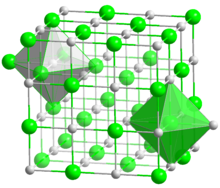
Back كربيد الهافنيوم الرباعي Arabic کاربید هافنیوم (IV) AZB Hafniumcarbid German Carburo de hafnio Spanish کاربید هافنیم (IV) Persian Hafniumkarbidi Finnish Carbure d'hafnium French Carburo di afnio Italian 炭化ハフニウム Japanese Hafnium(IV)carbide Dutch
 | |
| Identifiers | |
|---|---|
3D model (JSmol)
|
|
| ChemSpider | |
| ECHA InfoCard | 100.031.910 |
| EC Number |
|
PubChem CID
|
|
CompTox Dashboard (EPA)
|
|
| |
| |
| Properties | |
| HfC | |
| Molar mass | 190.50 g/mol |
| Appearance | black odorless powder |
| Density | 12.2 g/cm3[1] |
| Melting point | 3,958 °C (7,156 °F; 4,231 K)[2] |
| insoluble | |
| Structure | |
| Cubic crystal system, cF8 | |
| Fm3m, No. 225 | |
| Hazards | |
| GHS labelling: | |

| |
| Warning | |
| H228 | |
| NFPA 704 (fire diamond) | |
Except where otherwise noted, data are given for materials in their standard state (at 25 °C [77 °F], 100 kPa).
| |
Hafnium carbide (HfC) is a chemical compound of hafnium and carbon. Previously the material was estimated to have a melting point of about 3,900 °C.[2] More recent tests have been able to conclusively prove that the substance has an even higher melting point of 3,958 °C exceeding those of tantalum carbide and tantalum hafnium carbide which were both previously estimated to be higher.[3] However, it has a low oxidation resistance, with the oxidation starting at temperatures as low as 430 °C.[4] Experimental testing in 2018 confirmed the higher melting point yielding a result of 3,982 (±30°C) with a small possibility that the melting point may even exceed 4,000°C.[5]
Atomistic simulations conducted in 2015 predicted that a similar compound, hafnium carbonitride (HfCN), could have a melting point exceeding even that of hafnium carbide.[6] Experimental evidence gathered in 2020 confirmed that it did indeed have a higher melting point exceeding 4,000 °C,[7] with more recent ab initio molecular dynamics calculations predicting the HfC0.75N0.22 phase to have a melting point as high as 4,110 ± 62 °C, highest known for any material.[8]
Hafnium carbide is usually carbon deficient and therefore its composition is often expressed as HfCx (x = 0.5 to 1.0). It has a cubic (rock-salt) crystal structure at any value of x.[9]
Hafnium carbide powder is obtained by the reduction of hafnium(IV) oxide with carbon at 1,800 to 2,000 °C. A long processing time is required to remove all oxygen. Alternatively, high-purity HfC coatings can be obtained by chemical vapor deposition from a gas mixture of methane, hydrogen, and vaporized hafnium(IV) chloride.
Because of the technical complexity and high cost of the synthesis, HfC has a very limited use, despite its favorable properties such as high hardness (greater than 9 Mohs[10]) and melting point.[2]
The magnetic properties of HfCx change from paramagnetic for x ≤ 0.8 to diamagnetic at larger x. An inverse behavior (dia-paramagnetic transition with increasing x) is observed for TaCx, despite its having the same crystal structure as HfCx.[11]
- ^ Physical Constants of Inorganic Compounds in Lide, D. R., ed. (2005). CRC Handbook of Chemistry and Physics (86th ed.). Boca Raton, Florida: CRC Press. pp. 4–44 ff. ISBN 0-8493-0486-5.
- ^ a b c Harry Julius Emeléus (1968). "Metal Carbides". Advances in Inorganic Chemistry and Radiochemistry. Academic Press. pp. 169–170. ISBN 978-0-12-023611-4.
- ^ Cedillos-Barraza, Omar; Manara, Dario; Boboridis, K.; Watkins, Tyson; Grasso, Salvatore; Jayaseelan, Daniel D.; Konings, Rudy J. M.; Reece, Michael J.; Lee, William E. (2016). "Investigating the highest melting temperature materials: A laser melting study of the TaC-HFC system". Scientific Reports. 6: 37962. Bibcode:2016NatSR...637962C. doi:10.1038/srep37962. PMC 5131352. PMID 27905481.
- ^ Shimada, Shiro (October 1992). "Oxidation Kinetics of Hafnium Carbide in the Temperature Range of 480° to 600°C". Journal of the American Ceramic Society. 75 (10): 2671–2678. doi:10.1111/j.1151-2916.1992.tb05487.x.
- ^ Ushakov, Sergey V.; Navrotsky, Alexandra; Hong, Qi-Jun; van de Walle, Axel (26 August 2019). "Carbides and Nitrides of Zirconium and Hafnium". Materials. 12 (17): 2728. Bibcode:2019Mate...12.2728U. doi:10.3390/ma12172728. PMC 6747801. PMID 31454900.
- ^ Hong, Qi-Jun; van de Walle, Axel (2015). "Prediction of the material with highest known melting point from ab initio molecular dynamics calculations". Physical Review B. 92 (2): 020104. Bibcode:2015PhRvB..92b0104H. doi:10.1103/PhysRevB.92.020104. ISSN 1098-0121.
- ^ "Scientists Create World's Most Heat Resistant Material with Potential Use for Spaceplanes". Forbes.
- ^ Dai, Yu; Zeng, Fanhao; Liu, Honghao; Gao, Yafang; Yang, Qiaobin; Chen, Meiyan; Huang, Rui; Gu, Yi (15 October 2023). "Controlled nitrogen content synthesis of hafnium carbonitride powders by carbonizing hafnium nitride for enhanced ablation properties". Ceramics International. 49 (20): 33265–33274. doi:10.1016/j.ceramint.2023.08.035. eISSN 1873-3956. ISSN 0272-8842. OCLC 9997899259. S2CID 260672783.
- ^ Lavrentyev, A.A.; Gabrelian, B.V.; Vorzhev, V.B.; Nikiforov, I.Ya.; Khyzhun, O.Yu.; Rehr, J.J. (26 August 2008). "Electronic structure of cubic HfxTa1–xCy carbides from X-ray spectroscopy studies and cluster self-consistent calculations". Journal of Alloys and Compounds. 462 (1–2): 4–10. doi:10.1016/j.jallcom.2007.08.018.
- ^ James F. Shackelford; William Alexander, eds. (2001). CRC Materials Science and Engineering Handbook (3rd ed.). CRC Press. ISBN 978-0-849-32696-7.
- ^ Aleksandr Ivanovich Gusev; Andreĭ Andreevich Rempel; Andreas J. Magerl (2001). Disorder and Order in Strongly Nonstoichiometric Compounds: Transition Metal Carbides, Nitrides, and Oxides. Springer. pp. 513–516. ISBN 978-3-540-41817-7.
